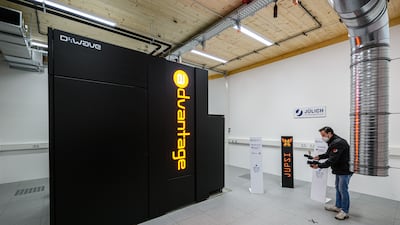The pace of change when it comes to quantum computing is accelerating fast. This is highlighted by Google’s latest quantum computer, which is 241 times more powerful than its 2019 machine. It can instantly make calculations that would take the world’s top supercomputers 47 years to crack.
The predictions around quantum computing vary widely, but statistics like this make it clear that it is on the horizon. As such, the need to be prepared is very real, including in the Middle East.
This is so salient in the region because GCC economies have proved to be open to new technologies in the past decade, from digital currencies to AI, and this is placing them in good stead for the future. But a tech-heavy landscape means new risks that must be considered, including when it comes to quantum computing.

It isn't yet clear what quantum computing will look like exactly, and when it will take flight, but taking that risk seriously and considering it early is likely to be a move that governments and businesses will not regret.
To understand the opportunity – and therefore the potential threats, let’s examine quantum computing a bit more. It really is an extraordinary technological advancement that has the ability to reach new frontiers for the good of humankind, but it could also become a weapon for bad actors.
For decades, hackers have persisted in the pursuit of valuable data, typically encrypted. In today's computer landscape, encryption methods can tire and ultimately thwart most of those with malicious intent, but quantum computing has the potential to change the game.
Quantum computers can crack codes in seconds that would be near impossible for traditional computers. This has the potential to open floodgates, enabling well-equipped malicious players to access and decrypt a vast array of highly classified confidential data.
How? Well, quantum computers can run algorithms that would be out of the question on classical machines. Classical computers use binary (0 or 1) bits, while quantum computers use qubits (short for quantum bits), which can exist in multiple states at once.
The way this technology can accelerate the exhaustive search of possible scenarios has enormous potential, not just risk: quantum computers may in the future rapidly solve optimisation problems and create new business opportunities. For example, these quantum technologies are being looked at to tackle anything from more efficient electric vehicle batteries to financial portfolio optimisation or the sourcing of rare minerals.
How are these computers built? That’s also complex. Building or creating a useful quantum computer requires the ability to rapidly solve particularly difficult mathematical, statistical or multivariant problems.
Advancements to help unlock the technology across fields of physics and engineering have been under way for decades. Mathematicians devise algorithms that call upon quantum computing to solve problems faster, physicists drive practicable theories to encode those algorithms into quantum systems and engineers set up and operate quantum systems with the needed performance, stability and scale.
There are still major hurdles to address. For instance, quantum machines of just a handful of qubits take up the space of a large room and the energy of a small suburb. Current hardware limitations represent a major thorn in the side of those advancing quantum capabilities.
With so many factors and possibilities to contend with across many studies and assertions, it is clear that the technology still has some way to go before the qubit count needed and the required stability in the quantum state are attained.
However, with each innovation and enhancement, "day zero", where a quantum computing enabled cyberattack happens, comes ever closer. The quantum threat has a particularly sharp focus: that of data protected by public key encryption, where such data is either at rest (stored on disc or memory) or in transit (especially when exchanged over the internet).
Today’s encryption techniques rely on the fact that conventional computers find it practically impossible to factor the product of two large prime numbers. EvolutionQ, a quantum cybersecurity company, recently published its Quantum Threat Timeline Report, which laid out the expectations of industry leaders as to when a quantum computer would be capable of compromising current encryption capabilities. More than half the respondents gave quantum computing a 50 per cent or greater chance of breaking a highly complex encryption called the RSA-2048 in 24 hours within the next 15 years.
A significant number of players consider the quantum threat to be imminent and are directing funding and talent accordingly. Led by Dr Marco Pistoia, JP Morgan’s Global Technology Applied Research team has begun developing quantum-secure solutions. Recently, the team demonstrated the ability of its Quantum Key Distribution network to defend a blockchain application from quantum computing-enabled attacks. JP Morgan’s work is evidence that larger institutions are already thinking about practical protection and defence capabilities in a post-quantum world.
Another key step is to create an inventory of existing data sets within an organisation that use conventional encryption methods. Formally mapping out the potential risk is important to understand the potential impact of the quantum-computing wave. This is particularly the case, as I mentioned, in the GCC, due to its tech-first approach. Smart citizen services, digital money and AI are being adopted fast across much of the region. This is almost entirely positive, but it does increase the potential risk map.
And the quantum computing risk is more about when rather than if. Each engineering advance reveals new practical possibilities. This makes the timeline challenging to predict. Regardless, it is paramount that organisations understand the implications of both the opportunities and the risks, and that they waste no time in doing so.

